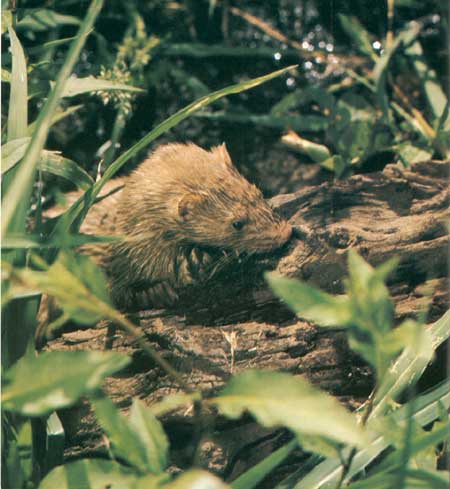|
GLACIER National Park |
 |
 The mink, a solitary predator associated with low-elevation watercourses, preys on anything it can catch and subdue. |
Plant-and-Animal Communities
Over Going-to-the-Sun Road
I like to begin with St. Mary, a lake the whitecaps love to run. From the far passes the several winds gather and collect, arranging long lines of white waves for the race downlake. Past the purple scree of Mahtotopa and Little Chief they go, white as the headdress of Going-to-the-Sun Mountain, colliding, collapsing along the promontory snares about the Narrows. Onward they press, spreading out and setting sail for the straight rush to the final shore where a line of cottonwoods sings with a sound like applause.
Across the lake the timbered ridge starkly contrasts the finger of prairie that claims the north shore. This is a flower-glad place, a meeting-ground for mountain and prairie plants. Along the road the grassland holds the conifers back, allowing only scattered clumps of aspens.
Finally, at Rising Sun, beneath the shadow of Goat Mountain, the prairie ends and wind-seasoned Douglas-firs announce the coming forest.
There's excitement now, with the prairie heat gone, the wind scent raw with fir and high meadows, honed by waterfall and tall, dank rock. Our mountain thirst is never extinguished, and a road that tightens down to cliff face and sudden turn brings back to our blood the ancient need to go to the highest place.
There is sword-edged Citadel, and the snow-flanked spike of Fusillade holding court like a queen in this valley of peaks; then the dome of Jackson and the Gunsight notch. Our eyes are kept high, transfixed at last by looming Heavy Runner and the distant promise of Reynolds.
Looking for mountain goats, we scan the walls around the sweep of Siyeh Bend, catching a glimpse of the trail that crosses the scree to hidden Piegan Pass.
Beargrass heads lean out above the road like old men conferring on the view. The purple trumpets of penstemon crowd the rocks, and spots of Indian paintbrush lead like a blood-trail to the higher slopes.
Intoxicated now, feeling the fresh full force of the wind from Logan Pass, we race on. We hardly notice the struggle of the forest in Reynolds Creek far below, how it thins and loses strength in its own hard climb. We sweep past it on the broad magnificence of this pass.
Level but a moment, the road dips to a shelf on the headwall above Logan Creek and swings over the great sculptured cliff of the Garden Wall. For several kilometers this masterpiece of a road glides down a constant grade, squeezed between rock face and space, twisting into tight drainages—a road for storm lovers, wet with spray and snow-seep, its quick turns concealing sudden winds.
Mighty, snow-robed Heaven's Peak appears, taking our attention from the Pass-group mountains and the hanging valley that spills Birdwoman Falls. Northward is the great array of peaks encircling distant Flattop, jumbles of mountains and glaciers. How are we to notice the forest far below?
Not until we have passed the Loop and are moving past the blackened snags of a recent burn do we realize the stature of this forest. The long road down will take us into a valley much deeper than any on the eastern side. Near Avalanche Creek are trees we have seen nowhere else in the park—giant western redcedars, western hemlocks with their nodding tops, monstrous black cottonwoods with bark so deeply furrowed that it looks hewn by hatchet.
We take a long ride down the valley, past the low pyramid of Mt. Stanton, final peak in the Livingston Range. Near the outlet end of Lake McDonald, birch and aspen again appear in numbers, and the road enters a crowded stand of lodgepole pine.
Our memories cluttered with mountains, waterfalls, and snowfields, we do not quite realize the significance of this 80-kilometer journey. We have crossed the boundaries of several different plant-and-animal communities, spanning a range of climate that would be encountered on a 5,000-kilometer north-south journey at sea level.
At first glance the various trees, wildflowers, and animals seem randomly distributed, scattered about like the distant mountains. But mountainous terrain represents an organized high-rise approach to life. From the lowest, most protected valley to the highest wind-and-ice-cut summit, the life-forms align themselves, each according to its own climatic tolerance.
Here too can be seen the great cycles of nature: fire and regrowth, the building of soil and its erosion, the incessant duel of the eaters and the eaten.
In the following sections we will spend some time in these various communities, from prairie to tundra.

|

|
|
|
|
Last Modified: Sat, Nov 4 2006 10:00:00 pm PST |


